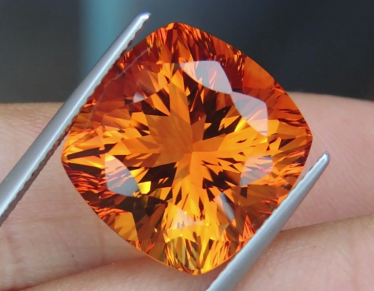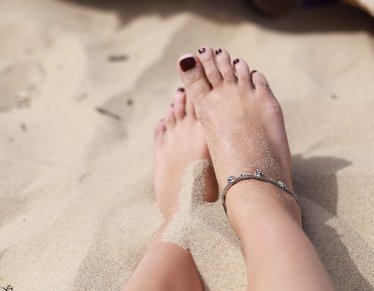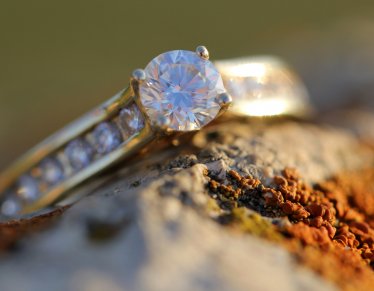What is sterling silver? This is a bit of a loaded question. On one hand, you might find yourself thinking you know a lot about it, but on the other, you might realize you don’t really know that much information about what sterling silver really is. So what do most of us know right up front about sterling silver?
Let’s talk about some myths and some facts about sterling silver!
Myths & Facts
1. First, sterling silver is just fake cheap silver. Is that true or false?
✗ The answer is false.
Sterling silver is an alloy of pure silver, simply meaning it is a combination of metals that includes a large portion of pure silver.
2. It will tarnish and probably turn your skin green right away. Is this a myth or a fact?
✓ This, in some ways, could be true.
Sterling silver can and will tarnish over time, and it does have the ability to turn your skin green. However, there are ways to prevent that and we will talk about that soon.
So overall, we will have to go with calling that one a myth, because if you put in the work as soon as or before you see any tarnishing, you definitely will not end up with green skin. Let’s do one more and then we will dive into the details of what sterling silver really is.
3. It is regularly labeled 925 sterling silver by the jeweler or the seller of the product.
✓ That one is true, true indeed.
The reason that sterling silver is often labeled this way is that it technically contains 0.925 parts pure silver. What does that even mean? We have found that the easiest way to understand it is to first establish that sterling silver is an alloy of pure silver as we mentioned before. Sterling silver is made up of 92.5 percent pure silver combined with 7.5 percent of another alloy metal type.
Typically the one that we see mixed with pure silver to make sterling silver is copper. This gives you the full 100 percent of sterling silver. So if it’s mainly made up of pure silver, why not just use pure silver to make jewelry?

This can be a bit confusing to understand unless you are a scientific guru. Which we have all sorts of respect for those of you that are. But ultimately, pure or “native silver” is found in the Earth’s crust. This metal is an alloy with gold and even with other metals. It is found in minerals like chlorargyrite and argentite. We most often get silver as a byproduct of refining other metals.
These can include lead, gold, copper, and zinc. Furthermore, once we have this pure silver, we potentially could make jewelry out of it. However, it has been found that pure silver is simply too soft to be able to work with to create things. That’s when the copper comes into play.
When combining the majority, 92.5 percent, of silver to just a small 7.5 percent of copper, we get sterling silver, right? Well this copper, though a low percentage, plays a big roll in the sterling silver alloy. It hardens the metal and makes it possible to use it to create things, such as jewelry.
Yes, that includes the ring you are looking into buying or that family heirloom necklace that your mother passed down to you just weeks ago. Sterling silver has been around for a long long time. But just how long are we talking here?
The who, what, when, and where of sterling silver
Though labeled differently at the time, it was first originated in the continent of Europe. This happened in what we now call Germany as early as the 12th century. This sterling alloy has been around for an impressively long amount of time. In Colonial America, we started using it for currency and general goods nearly four hundred years ago. Isn’t that incredible?
The silversmiths of the time worked most often with sterling silver to create quality products. Eventually, Paul Revere, a silversmith of the time, had a major breakthrough when he acquired a silver rolling mill from England.
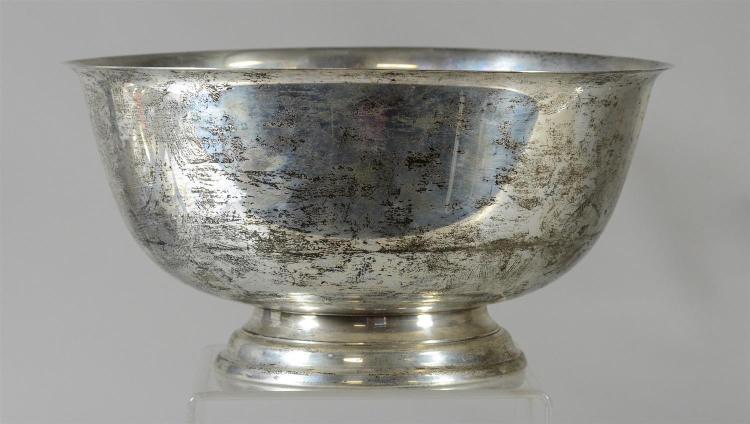
This allowed him to produce large amounts of sterling silver to sell to other silversmiths. He also made products from it, included low-end goods that would eventually make him a fortune. One of the main goods he produced was sterling silver flatware on his mill. It’s intriguing to try to flash back to that time, to visualize this period, when something like this would have been such an incredible breakthrough and game changer to the world of sterling silver.
How is it made?
Obviously, times have changed, and that mill has evolved into incredible machines that are used to make mass amounts of sterling silver. Though there are different ways to produce it, the overall process is the same. Let’s take a look into what it might look like in a factory where it is produced.
First, the liquid 92.5% of pure silver is combined with 7.5% of the alloy, typically copper as we mentioned before. This is poured into some sort of mold, stainless steel for example, where it cools rapidly and becomes a hard and stiff bar. The bar of metal is then fed through a press made of two rollers.
They send it through numerous times, each time the heavy rolls put thousands of pounds of pressure onto the sterling silver. After it has gone through the rolls, it comes out thin and brittle. It is then reheated to restore its stiffness and flexibility.
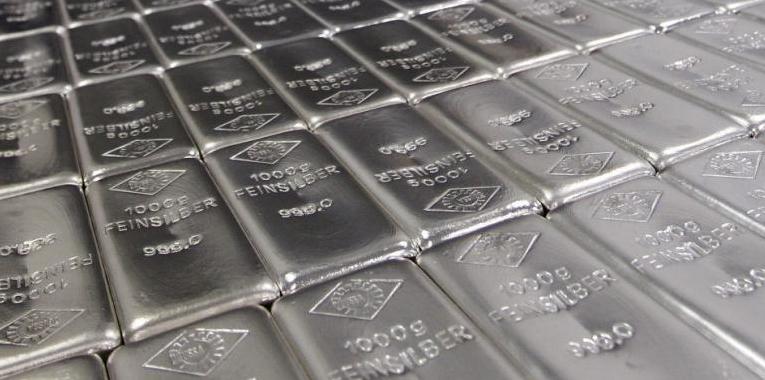
Afterward, they put the bar in another rolling press to flatten and thin it out even more. At this point, the once thick bar of sterling silver has become a long thin sheet of metal. This process can dramatically change the length of the bar of up to fourteen times its original length. Though it can seem like a long process, it sounds pretty fascinating, doesn’t it? But we’re not quite done.
After they have put the bar through these steps, they then put the strip of sterling silver into numerous forming rollers. After it goes through the process, it is eventually turned into a tube and is then soldered, or put through high temperatures to join fusible metals. It is still too thick to turn into some kinds of jewelry though, so it is put through more thinning machines and then winding machines to curve the metal.
There is even more to the process during all of that, and dozens of steps after that, it gives you an idea of the amount of work that goes into creating a pair of earrings, necklace, or ring.
What is Sterling Silver Worth?
With all of that work being put into it, it’s got to cost a fortune, right? Your opinion may be swaying a little bit if you started reading this thinking that sterling silver is a cheap and flimsy metal. We have seen a little different side of how this metal comes to be, rather than the myth about it being cheap. This is quality metal that endures quite a process to create, and don’t forget that it is largely made up of pure silver.
The price of a sterling silver piece of jewelry can vary greatly. And though the metal does matter, as you want to make sure you are getting real 925, the price tag doesn’t always reflect just the metal alloy that is being used to create the product. The reason we say that is because you may be able to find a piece of jewelry that is extremely low cost and made of 925 sterling silver. However, you may find a piece that says it’s 925 and find yourself wondering why it has such a fancy price tag attached to it. There are a few reasons that this price can so greatly fluctuate.
One reason depends highly on the type of gem that may be included in the piece you are buying. Say that you are buying a gorgeous ring that you found at an outstanding price of under $20. How can that be? Yes, that ring may be made of sterling silver, but look closely at the description of the gems. Are you going to be able to find real diamonds at that price, the answer we’ll tell you pretty confidently, is no? However, this ring with cubic zirconia, still absolutely stunning, is not a shocker to see at that price.
Let’s move onto another product to get an idea of the price tag we may see on 925 sterling silver. We found an abundance of necklaces that cost anywhere from a couple of hundred dollars to just over $1,000. How can this be when it is also sterling silver?

A big reason, probably the main reason, that these necklaces are this expensive is because they have a brand name on them. Often times we pay just as much or more for the name brand as we do for the actual material of the product. These pieces are absolutely beautiful and are sure to last you decades with proper care, especially since this same brand offers you special cleaning solutions for your necklace. These are necklaces that are timeless and you will treasure for years to come.
So our original question was: is sterling silver expensive? The answer can be yes, but it can also be no. The best answer to these questions is that it fluctuates greatly.
Aside from purchasing true 925 sterling silver, the price is strongly determined by the brand value of the product as well as the details that are added to the sterling silver piece, such as diamonds and pearls.
What is it used for?
We all know that it is used to make many kinds of jewelry. For example, you can find earrings, rings, necklaces, anklets, bracelets, and watches made of sterling silver. Pretty much any kinds of jewelry you are looking for, you can find it in this metal. This product is often sought after because it is gorgeous, timeless, and you can find it at a price that is right for you.
It is also durable and hypoallergenic which makes it desirable for men and women as well. But aside from all of the jewelry, is sterling silver used to make anything else? Yes, yes, yes!
Because it is tougher than pure silver, due to its combinations of 0.925 part pure silver and 0.075 copper (or a combination of alloys), it is able to withstand wear and tear better than pure silver can. It is also more easily used to create products because of the hardness that comes from mixing pure silver and an alloy.
Can you think of any items that you know are made of it? We’ll give you a hint, most of you probably have a product or two in your home. That’s right, it is regularly used to create the things we use most in the kitchen. This includes flatware like we recall Paul Revere using it for many centuries ago. It can also be used to make serving trays and other decorative tableware. But that’s not all.

Did you know that high-quality musical instruments, such as a flute, can also be made of sterling silver? Isn’t that cool? We love looking at all the value that it has, though jewelry is, of course, our favorite use for it.
What are the benefits of sterling silver?
We could go on for days about the benefits. But let’s focus in on a few. First of all, it is extremely popular, so it’s obviously literally benefiting people on a regular basis. Because of its durability, price, and lastingness, people really just can’t get enough of it!
It is extremely versatile when it comes to jewelry as well. You can pair it with jeans and a t-shirt for your everyday look, we’d even go as far to say a pair of sterling silver stud earrings in your leggings and an active tank top at the gym.
But it’s also regularly seen worn in elegant pieces with gowns and business attire. There is no limit with it, dressed up or dressed down, therefore people are absolutely crazy about it. We are as well! It’s a product that you can trust to remain timeless as well as hold up to your wearing standards.
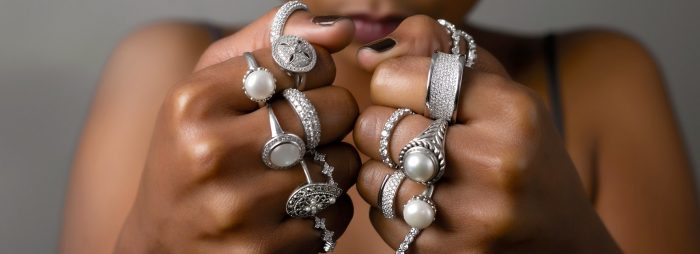
Another benefit of sterling silver is that it is healthy. Healthy? What do we mean by that? Studies have shown that up to 10% of people are allergic to the metal nickel. Because of this, it hinders the use of nickel in jewelry especially, since we often wear it all day. With that being said, we all know by now that it is made up of pure silver and copper.
This keeps people, especially young women who are at great risk for allergies to nickel, at less risk to be dealing with allergies to their jewelry and breaking out in scabs or red irritated skin.
We’ve already talked about the price, which can seem like a steal of a deal compared to that of yellow-gold or white-gold. You are able to add to your jewelry collection as much as you like, or at least a little more often than you would with other types of jewelry. With its durability, long lasting, price friendly qualities, it makes for a fantastic route to go when shopping for jewelry.
What are the disadvantages?
This may seem a bit confusing since there are so many fabulous benefits. But with all the things that are good or even great in our lives, we know that nothing and nobody is perfect. So what disadvantages do we see when it comes to sterling silver? We will discuss a couple that you may run into.
First of all, sometimes products can be a bit misleading about the integrity of it, as with any metal that may be used to make jewelry. Let us explain. If you are looking to purchase a piece of jewelry that is labeled sterling silver by the seller, you want to make sure that it is actually made of true sterling silver.
Often times we see pieces that are simply silver-plated. These pieces may be made up of nickel and simply plated in sterling silver. This, of course, hinders the benefits that you are looking for, like the durability and especially the fact that it is hypoallergenic, which nickel is not. So how do you avoid regretting your purchase of what you thought was a sterling silver ring?
Luckily, all true sterling silver pieces, that are fully crafted of sterling silver, will be stamped, labeled, or engraved with “sterling” or “925”. Now don’t expect to see this the second you look at the ring, as it is typically hidden and written very small. So do your research before purchasing and you can make sure to avoid this disadvantage, or what could be a disadvantage, or purchasing sterling silver.
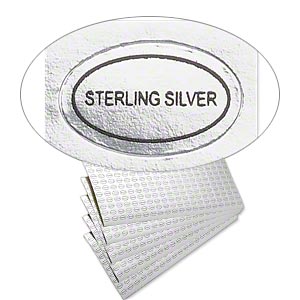
Another disadvantage that you may be concerned about is longevity. Doesn’t it tarnish easily? The metal is desirable often because of its breathtaking shine, but nobody wants that to disappear in a matter of days only to end up with a discolored ring and even possibly a green finger.
Tarnishing occurs when the copper alloy oxidizes, simply by coming in contact with air, sulfur, and water. So yes, it might tarnish. But that doesn’t mean that it is ruined or even unfixable. First of all, take precautions when wearing your sterling silver jewelry just as you would with any kind of metal.
Don’t wear it swimming or in the ocean as it may turn black. Be mindful of what you are exposing it to in your everyday routines, such as hairspray and perfume or house cleaning supplies. But don’t stress yourself out if you accidentally do get some of these products on it, because there are ways to clean it and repair it to its gorgeous original state. We’ll talk to you more about cleaning your jewelry soon. Before we move onto that, let’s talk about one more thing.
You may be thinking that in order to get the longest life out of your jewelry and to ensure it won’t tarnish, you just will make a point not to wear it too often, right? Pull it out for special occasions, and nothing in between. Or maybe you could wear one piece for a couple of weeks and then put it away in your jewelry box for a few months while you alternate through other pieces.
As much as we can understand where you might be formulating that thought, we want to encourage you to wash it away quickly from your mind. We say this because wearing your ring is actually good for it. What? How can that be?
Well, it turns out the natural oils that you release from your skin actually work as cleaners for your rings. So instead of depriving it in your stash of jewelry you keep in your bathroom, wear that ring! Flaunt it and continue loving it every day like the first day you bought it, without forgetting it in the dark abyss of your jewelry box.
How do you clean sterling silver?
Unfortunately, whether you are going to be wearing it on a regular basis, or even if you do choose to stash it away for a special day in your jewelry box, it will end up tarnishing either way. More times than not, you will experience that with sterling silver, so it’s best to expect that when going into it. However, that doesn’t have to seem as dramatic or as big as a deal as it may sound.
There are truly very easy ways to clean your sterling silver to prevent it from tarnishing or to revive it as soon as you spot that first sight of discoloration. First, we want to note that this process will vary a little bit if your ring, necklace, bracelet, earrings, or any type of jewelry happen to have gemstones on it. Some methods will damage the gemstones, such as diamonds or pearls, if you do not modify the cleaning process. So be mindful of that, but we will walk you through both methods.
First of all, we will go through the steps of how to clean those pieces that are simply 925 sterling silver, the ones that you don’t have the concern of gemstones being ruined.
For starters, you will mix ½ a cup of white vinegar with 2 tablespoons of baking soda. This concoction will be fizzy, so don’t let that startle you. Place your jewelry in the solution and let it soak for two to three hours. After which, you will take the jewelry out, rinse it off the solution in lukewarm water, then dry it with a soft towel.
This will remove the tarnish build up and give you the freedom to polish your sterling silver again and bring it back to its original shiny and glamorous look.

For those of you who are worried about cleaning your piece of jewelry that has some sort of gemstones, this next method is for you.
You will need warm water, mild dish soap, a soft-bristled toothbrush, and a soft towel. Make sure that your dish soap does not have any type of chlorine or strong products in it before you begin. Now that you have your supplies, you are ready to get started.
Distribute your warm water into two separate bowls. Unlike the last method, you do not need to be concerned about an exact measurement here.
Simply put clean warm water in one bowl, and clean warm water in another. In just one of the clean bowls, add enough of the mild dish soap to make the mixture a soapy consistency. Dip the toothbrush into the soapy water and then gently scrub your ring clean. This solution will not damage the sterling silver or the gemstones, and as long as you are careful it will absolutely get the job done.
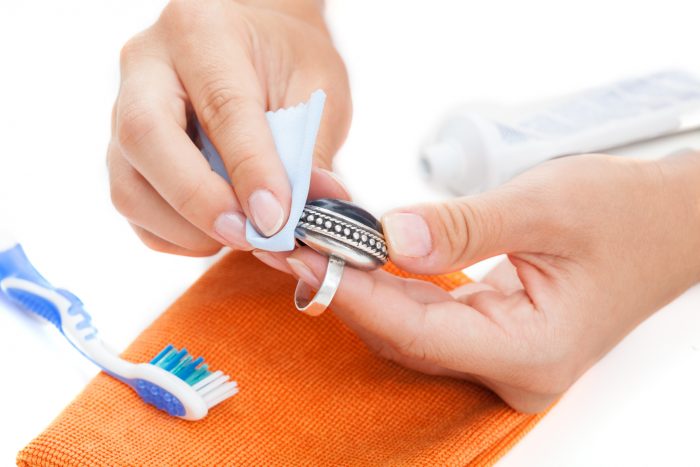
Once you have cleaned the ring, dip it in the clean water from the other bowl. Dip it in just long enough to rinse off any remaining soap, and then use your soft towel to dry it off thoroughly. And just like that, you’ve got a gorgeous and shiny piece of jewelry again!
In conclusion, sterling silver is a fantastic option when you are buying jewelry. It is long lasting, durable, easy to care for, and often times very budget friendly. Now you know everything there is to know about sterling silver, you can decide which metal type is best for you.
Whether you have become a lifelong advocate of this metal, or you simply feel more aware in your preference of metal, we hope you can confidently shop for the kind of jewelry that you like best!

